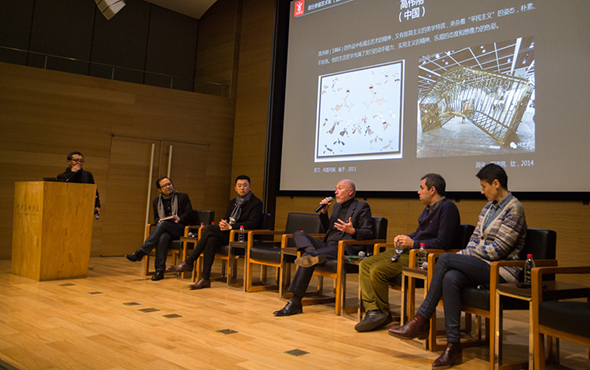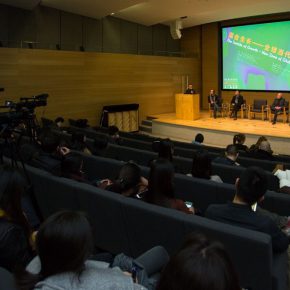
On the evening of December 13, 2016, the lecture entitled “The Jumble of Growth – A New Global Zone for Contemporary Art” was held in the Auditorium of the Central Academy of Fine Arts. This lecture was jointly organized by the CAFA Art Museum and the Today Art Museum. On the occasion of the recent opening of the Third Today’s Documents at the Today Art Museum, invited Prof. Wang Chunchen, Head of the Department of Curatorial Research of CAFA Art Museum and Huang Du, curator of the Third Today’s Documents and a critic to all serve as the hosts of the event and discussion and they were together with Dr. Gao Peng, Director of the Today Art Museum, the Cuban curator of the Third Today’s Documents Gerardo Mosquera, as well as the famous contemporary artists from Spain?Fernando Sánchez Castillo and?Cristina Lucas who offered a communication session, this started from the works in the exhibition of documents and the exhibited works with an in-depth discussion of how the ever-changing globalization attacks and impact of the current and future social, cultural, artistic ecology and trends.
Prof. Wang Chunchen first introduced that, the Third Today’s Documents made changes in the global pattern brought by the “BRIC” (China / Brazil / India / Russia) and the new opportunities, challenges and problems offered a perspective of observation, adding the acronym “BRIC” in the theme of the exhibition, and the perspective directly penetrated into the core of the exhibition. At the same time, Wang Chunchen also recommended the co-curator of this exhibition, the internationally renowned curator and founder of the Cuban “Havana Biennale” Gerardo Mosquera’s book entitled “Unbounded Island”, and talked about how China and Cuba had a similar social structure and context, the Havana Biennial responded to the multi-cultural issues under globalization, which China also faced.
Gao Peng, Director of Today Art Museum said Today’s Documents have been held three times since 2007, and research themes and curatorial programs have been adjusted and advanced in accordance with the changes of the world and the topic over a long period of time. It is presented in Chinese, English and French, and divided into four parts “The Jumble of Growth”, “Chaotic Space”, “Discourse Practice” and “Individual Narrative and Microscopic Bodies”. “The Jumble of Growth” is proposed because the world has gradually changed from the “pan-globalization” that originally emphasizes regional differences to a new and unified “ethnic group”, and with the rapid development of the internet and economy, the theory and understanding of globalization also changed, resulting in the topic discussed by the theme of this exhibition. It seems that “Today” and “l(fā)iterature” are contradictory, but it precisely reflects the curator’s unique philosophy, namely to abandon the discussion taking “curating” as the text and taking “present” as the text to push the artist to the front of the exhibition.
Curator Gerardo Mosquera said the complexity of this exhibition of documents didn’t only stem from the different cultural backgrounds of the artists participating in the exhibition, but also from the multiple visual shocking elements of the works. As technology advances, the world undergoes an unprecedented rapid transformation, especially in the third world countries, the modernization of the transformation and the process is particularly prominent and rapid. However, it has brought destructive impact and problems. For example, along with the development of urbanization, people from the marginal areas gather into the cities which has led to the emergence of slums, while the traditional culture and the existence of marginalized groups must be adjusted in order to blend into the city. These changes are reflected in contemporary art, so that contemporary art itself becomes more complex through these complex problems. In addition, he also mentioned that the audience could see the contemporary artworks from across the world through this exhibition, so that this exhibition is also of similar quality to the biennial.
Then the curator Huang Du continued with the issue of Mosquera and said that looking at the issue of personal status when people were in the face of today’s cultural sphere has been impacted on by globalization? In the context of globalization, “identity” is not a single issue any more, but open and dynamic. Culture also emerges as a new model of mobility in this change, and more and more artists appear with a “nomadic nature”. Seen from all levels, today’s society is a dynamic society. The significance of this exhibition is bred in this context. In addition to using the exhibition to understand contemporary art and artists, does it need to go through the exhibition to think of the current and future development trends? How does art “capture” a variety of trends? What are the new relationships between art and changes of society, economy, and politics which is produced and how are these changes reflected? Seen from the exhibition, contemporary art is increasingly becoming an “art of intervening”, becoming more and more closely related to the context of reality and culture.
Following this, the artists Fernando Sánchez Castillo and Cristina Lucas respectively started from their own art learning and creative background as the entry point, to share their creative inspiration and internal thinking of the exhibited works with the honored guests.
Castillo’s work Terra-Cotta Warriors was created by Jingdezhen’s workers, but the terra-cotta’s culture itself is included in the view from multiple perspectives, for example, the audience can take them as toys. “Terra-Cotta Warriors” is like a representative souvenir, the history and culture is involved in the exchange between the artists and workers, while the artist also thinks of the relationship between the “Terra-Cotta Warriors” as a representative commodity and modern consumer society. It also confirms that “Art is a different perspective to allow us to find the problem” said by Castillo. Lucas’s works use photography as a medium to explore and analyze the complex relationship between present society, consumption, desire, and identity in the form of a light box advertisement. She said that, the advertising of the Western products tended to be considered in a Western form, which was also common in Oriental areas where the goods are sold, but the idea should be tied to demand in order to better identify their own identity.
In addition to the works of the two artists, the participating work entitled“Theorem” by the artist Gonzalo was also discussed, by using skillful an architectural space, style, cultural background and outdoor light, as well as projecting the famous phrase of “The best technique is less technique” from the “Mustard Seed Garden” on the fa?ade wall in neon lights, showcasing the thinking transformation of traditional and contemporary, the Oriental and Western, the orderly and disorderly. Curator Huang Du questioned the international curator Mosquera about the relationship between the Orient and the West which was presented in a global cultural environment centered on Europe and the United States after the end of the Cold War? Mosquera replied that, the relationship between the Oriental and the West would become more mobile and complex. The previous exchange was often one-way, but now the process of globalization is increasingly diverse, and shows a multi-polar situation, various poles also become more interactive and integrated.
After the end of the lecture, the guests and the audience had a more in-depth and expansive exchange with a richer interpretation of the issues extended by the exhibition, and this also triggered further reflection by the audience.
Text by Wei Xiankun, translated by Chen Peihua and edited by Sue/CAFA ART INFO
Photo by Hu Sichen/CAFA ART INFO





































